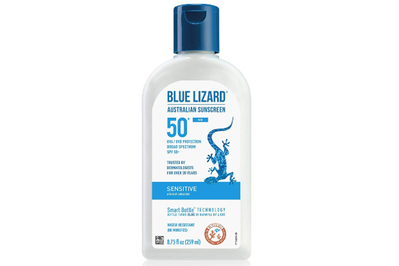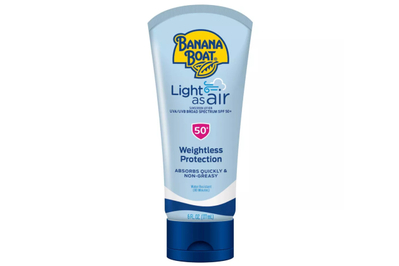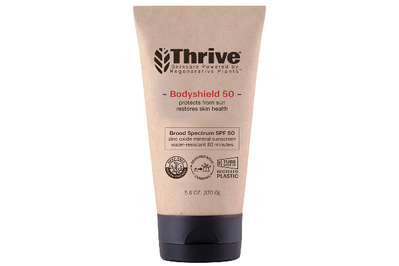Lots of People Apply Sunscreen Wrong. Here’s How to Do It Right.

Rose Maura Lorre is a writer on Wirecutter’s discovery team. She has reported on turkey fryers, composters, body pillows, and more.
The best protection against sun damage is to shield yourself from the sun’s rays entirely. But that’s rarely practical. And even with all of the sunglasses, rash guards, sun hats, and UPF clothing in the world, you usually still need a second line of defense. That’s where sunscreen comes in.
For many of us, that’s also where the questions start: How much sunscreen do you need? How often do you need to apply it? And does the type of sunscreen you use matter?
The short answers: You need 1 liquid ounce, applied roughly every two hours; any non-expired sunscreen labeled “broad spectrum” (which means it protects against both UVA and UVB rays) with an SPF of 30 or higher is a good option, according to the American Academy of Dermatology. (All of the picks in our sunscreen guide—as well as every sunscreen we recommend, including reef-safe and face sunscreens—meet these criteria. We chose physical and chemical sunscreen formulas that are easy to apply and wear, and that generally cost less than the competition.)
Read on for expert-backed sunscreen application and reapplication tips.
Our pick
This physical sunscreen lotion absorbs easily and is free of added fragrance. Although it can feel greasy and leave behind a white cast, it’s less visible on skin than most physical sunscreens.
This easy-to-apply lotion lives up to its name: It has a dry, transparent finish and is nearly colorless on skin. It does have added fragrance but not an overpowering, sunscreen-like scent.
For visiting the beach—or anywhere requiring a “reef-safe” sunscreen—we recommend this oxybenzone- and octinoxate-free physical sunscreen lotion. It feels great on the skin, and it’s among the least expensive formulas of its kind.
Buying Options
Which SPF is best?
The American Academy of Dermatology recommends using a sunscreen with an SPF of at least 30. However, numerous studies on sunscreen usage have found that no matter what SPF people use, they routinely apply less sunscreen than needed for optimal protection, and they don’t reapply frequently enough, either.
To compensate for that, you might want to consider using a higher-SPF sunscreen. As we report in our sunscreen guide, “Your chances of getting an effective SPF above 30, regardless of what the label claims, are better if you buy a sunscreen labeled SPF 50 or even 70.”
Whatever SPF rating you choose, though, you still need to reapply that sunscreen with the same frequency. All sunscreens, no matter their SPF, need to be reapplied at least every two hours.
How much sunscreen to apply

It takes about 1 liquid ounce of sunscreen to properly cover most swimsuit-clad adult bodies. If you have no idea what that amount looks like, it’s roughly 2 tablespoons, or the amount that would fit into the cupped palm of a medium-size adult hand.
That amount can also include the sunscreen you apply to your face. As far as sun protection is concerned, “regular” sunscreens and face sunscreens are the same. (If you do apply face sunscreen separately, we note in our guide to the best face sunscreens that a quarter-size amount of liquid sunscreen is sufficient for the face, neck, and ears.)
Our pick
This mineral sunscreen spreads easily and leaves no white cast. But it takes a little time to rub in, and it feels tacky to the touch for a few minutes after it’s applied.
This chemical sunscreen is lightly scented, moisturizing, and thick, and it leaves a dewy finish with no white cast. However, some testers had a hard time rubbing it in, and it tends to feel sticky.
Stick and spray sunscreens seem to present a pleasant alternative to slathering lotion all over your body and face by hand. But here’s the rub: You still need to rub them in.
Stick sunscreens aren’t as easily measurable as lotions, and their format makes them less practical for full-body application. If you do use one, however, the American Academy of Dermatology recommends that you apply “four passes back and forth” over every part of your body, and then rub it all in by hand.
With spray sunscreens, it may be even trickier to gauge just how much you’ve applied. If you do use a spray sunscreen, there are a few application strategies that should help you get better coverage.
The AAD suggests positioning the container’s nozzle close to the skin and spraying until the skin glistens. Immediately after spraying, rub in the sunscreen vigorously, even if the directions say there’s no need to rub it in. To avoid inhaling particles, which could pose a health risk, it’s also important to apply the product in a well-ventilated area. And never spray directly onto your face; instead, spray the sunscreen onto your hands, and then rub it in.
No matter which kind of sunscreen you use, make sure you really apply it all over. Researchers have reported that the ears and the tops of the feet typically receive the worst sunscreen protection, so don’t forget them. The team’s findings also suggest that, whenever possible, it’s better to have someone else apply sunscreen to your back than to try to do it yourself.
When to apply (and reapply) sunscreen
It’s best to apply sunscreen before you head into the sun—at least 15 to 20 minutes prior to sun exposure. To be the most effective, sunscreen needs time to soak in.
No matter what kind of sunscreen you use or how big the SPF number is on the bottle, the clinical consensus on reapplying is this: Reapply after you’ve been in the water, after any sweat-inducing activity, or after one to two hours—whichever comes first.
However, when you’re out and about, whether you are working hard or having fun, you may find it difficult to be diligent about your sunscreen reapplication. If you need a more structured way to remember to reapply, you can use this imperfect yet good-enough two-step plan, determined by researchers who reviewed several studies on sunscreen application:
- Apply the first coat 15 to 20 minutes before sun exposure.
- Apply the second coat within your first hour of sun exposure. (You can set a timer on your phone to remind you to reapply.)
This strategy will provide what should be a satisfactory amount of coverage. But experts agree that the best plan is to reapply regularly and generously, every one to two hours spent in the sun or after any sweating or water exposure.
How to apply sunscreen to your scalp or beard
Any skin atop your head that’s exposed to the elements—whether you’ve got a fully bald pate or just a part to protect—needs shielding from the sun. Hats are your best bet (especially those that offer UPF 50+ protection, like our recommended sun hats for hikers), but you can use sunscreen if needed. Just remember to rub it in, and reapply it as you would on any other part of your body.
The Skin Cancer Foundation says you can use “any type of sunscreen that works for your face” on your scalp. Facial sunscreens tend to be formulated with less (or no) oil.
The same advice applies when you are covering stubbly facial hair, according to the AAD. There’s no need to apply sunscreen on top of facial hair that fully covers the skin beneath it, as a full beard does.
And when hair itself is exposed to the sun, it doesn’t pose a risk to your health, though it might alter the color or texture.
What to know about applying sunscreen on kids
Few moments are as frustrating as when you’re trying to smear sunscreen on a child who wants nothing more than to squirm out of your gooey grip.
If a kid is old enough to apply their own sunscreen, keep this in mind: A study of 87 children (between the ages of 5 and 12) found that kids applied the most sunscreen on themselves when they used a pump to dispense the product versus when they used a squeeze bottle or a roll-on.
Pump bottles can also provide a (slightly) less messy application experience overall, regardless of whether a child or caregiver is performing the task. Though pricey, the chemical sunscreen Supergoop Play Everyday Lotion SPF 50 (which is one of our face sunscreen picks and is available in an 18-ounce pump bottle) has long been a Wirecutter staff favorite because of how nice it feels to apply. We also recommend Equate Sport Broad Spectrum Sunscreen Value Size SPF 50, a less-expensive chemical sunscreen that comes in a 32-ounce pump bottle.
Budget pick
This store-brand chemical sunscreen is surprisingly pleasant to use. It rubs in easily, feels good, and looks nearly invisible on all skin tones. Its polarizing medicinal smell can be a dealbreaker, however.
Buying Options
Our pick
This chemical sunscreen rubs in easily and appears nearly transparent once applied. It has a light, pleasant scent, and it comes in four sizes, including an 18-ounce jug.
For kids who are especially sunscreen-averse, you may want to try using a tool that can make application more pleasant. Some Wirecutter parents rely on a makeup or foundation brush to “paint” the lotion on the skin before rubbing it in.
There are also products designed specifically for sunscreen application. One such product, Solar Buddies, purportedly sidesteps the need to involve hands in the application process. You transfer sunscreen into the Solar Buddies container, and then you dispense it directly onto your skin via its roll-on sponge applicator. In practice, though, some testers found they still needed to rub in sunscreen by hand after rolling it on. The device is also tricky to clean.
Kids who are old enough to apply their own sunscreen may prefer using a stick or a spray sunscreen. Just make sure they generously apply the sunscreen and thoroughly rub it in.
Although the above tips might not make the application and reapplication completely painless, we like to tell our kids: You know what hurts more than applying sunscreen? A sunburn!
This article was originally published in 2022. The 2024 version was edited by Catherine Kast and Tracy Vence.
Meet your guide

Rose Maura Lorre
Rose Maura Lorre is a senior staff writer on the discovery team at Wirecutter. Her byline has appeared in The New York Times, Esquire, Salon, Business Insider, HGTV Magazine, and many more. She lives in New Jersey with her husband, her daughter, one dog, two cats, and lots and lots of houseplants.
Mentioned above
- The right pair of sunglasses will protect your eyes while broadcasting your own personal style. We found seven high-quality pairs that won’t break the bank.The Best Cheap Sunglasses
- Time at the beach, lake, or pool is more fun for everyone with kids outfitted in comfortable, protective swimsuits, rash guards, sun hats, and more.The Best Kids Swimsuits, Rash Guards, Sun Hats, and Other Beachwear
- It takes a shot glass’s worth of sunscreen to adequately cover a body in a swimsuit. Look for broad spectrum SPF 30 or higher and a scent and feel you like.The Best Sunscreen
- Thrive Bodyshield SPF 50 is our favorite reef-safe sunscreen. It’s also a great option for anyone who prefers sunscreens without chemical UV filters.The Best Reef-Safe Sunscreen
- Sunscreen is personal, and the one you choose to slather on your face is even more so. Here are 10 options to suit different preferences and budgets.The Best Sunscreens for Your Face
- After research and 200 hours of field-testing, we’re convinced the Sunday Afternoons Ultra Adventure Hat is the best sun hat for most people.The Best Sun Hat for Hikers
Further reading
40+ Wirecutter-Recommended Sun Protection Picks
by Gabriella DePinho and Wirecutter Staff
A robust selection of gear we like that’ll help stave off sun damage all summer, including sunscreens, sunglasses, children’s beachwear, and UPF clothing.
Sun-Protective Clothing Is a Reliable UV-Blocker. Here Are Some Options We Love.
by Sarah Gannett
Covering up is a great way to protect yourself from the sun. But you can do better than a white linen shirt.
Sunscreen: Scourge and Savior
by Ganda Suthivarakom
In this week's newsletter: Summer is around the corner, and we have new sunscreen recommendations for soaking up the sun safely.
You Should Be Wearing Sunscreen on Your Face Every Day
by Shannon Palus
No matter which formula you prefer, daily sunscreen use is among the most effective forms of skincare.











